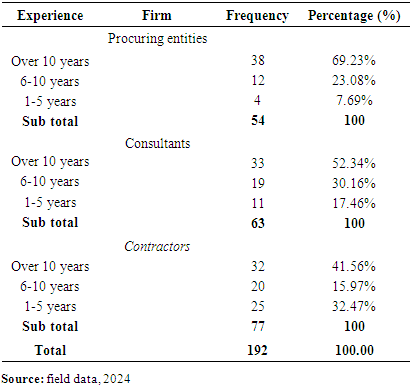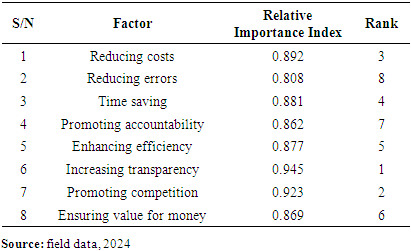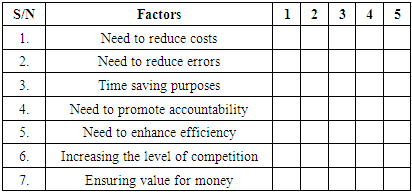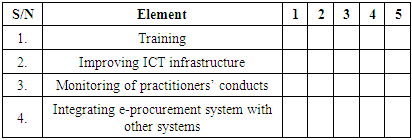-
Paper Information
- Paper Submission
-
Journal Information
- About This Journal
- Editorial Board
- Current Issue
- Archive
- Author Guidelines
- Contact Us
International Journal of Construction Engineering and Management
p-ISSN: 2326-1080 e-ISSN: 2326-1102
2025; 14(2): 53-60
doi:10.5923/j.ijcem.20251402.02
Received: Mar. 6, 2025; Accepted: Mar. 26, 2025; Published: Mar. 29, 2025

Assessing the Effectiveness of E-Procurement in Addressing Public Procurement Challenges in the Tanzanian Construction Industry
Judith V. Aron1, Rehema J. Monko2, Kimata Malekela3
1Graduate in Master of Science in Construction Economics and Management (SACEM), Ardhi University, Tanzania
2Lecturer at the School of Architecture, Construction Economics and Management (SACEM), Ardhi University, Tanzania
3Lecturer and Head of Building Economics Department, School of Architecture, Construction Economics and Management (SACEM), Ardhi University, Tanzania
Correspondence to: Judith V. Aron, Graduate in Master of Science in Construction Economics and Management (SACEM), Ardhi University, Tanzania.
| Email: |  |
Copyright © 2025 The Author(s). Published by Scientific & Academic Publishing.
This work is licensed under the Creative Commons Attribution International License (CC BY).
http://creativecommons.org/licenses/by/4.0/

This study investigated the effectiveness of e-procurement systems in addressing procurement challenges within the Tanzanian construction industry. A cross-sectional study design was employed in order to obtain both primary and secondary data. Quantitative data were collected through questionnaire administered to 192 respondents while secondary data were collected through document review. Descriptive statistics were used to analyse quantitative data. The study findings established that e-procurement enhances efficiency, transparency, and cost savings. On the other hand, improving e-procurement in the construction industry requires trainings and building capacity, refining network and ICT infrastructure, and monitoring procurement practitioners' conducts in relation to e-procurement. According to the study’s findings, e-procurement systems must be integrated with other systems, important public procurement players should regularly have capacity building, and legal frameworks for procurement be reviewed. The study concluded that e-procurement system should integrate with other systems, regular capacity building be conducted among key stakeholders in public procurement, and for the government has to review key legal frameworks on procurement.
Keywords: Procurement, Transparency, Accountability, Corruption and Competition
Cite this paper: Judith V. Aron, Rehema J. Monko, Kimata Malekela, Assessing the Effectiveness of E-Procurement in Addressing Public Procurement Challenges in the Tanzanian Construction Industry, International Journal of Construction Engineering and Management , Vol. 14 No. 2, 2025, pp. 53-60. doi: 10.5923/j.ijcem.20251402.02.
Article Outline
1. Introduction
- Businesses all around the world have depended on conventional means to acquire goods and equipment via middlemen [6]. The advent of e-commerce in the 1990s marked the beginning of e-procurement [31]. The construction industry's interest in e-procurement began in early 2000s [42]. In developing economies, construction procurement is notably conventional and slow to digitalize. The industry's procurement and supply chains are often criticized for inflated costs, attributed to a lack of transparency and trust among stakeholders [1]. Although e-procurement has proven efficient, transparent, and cost-saving in other sectors, its integration into construction industry faces significant hurdles such as incompatibility and security issues as well as resistance from individuals [19]. Also, it was reported that political connections aggravated directing resources to more efficient firms by reducing uneven information, nurturing informational flow between the private sector and the government [4]. On the other hand, political connections simply allow firms to receive contracts regardless of their capabilities and financial strength leading to procurement problems like delays in supplies [7]. Generally, politicians can confront professionalism like procurement practitioners by giving radical directive in order to favour a certain business entity in public procurement. For instance, a study by [28] on the effects of political interference on procurement performance in the parastatal organisation in Dar es Salaam region revealed that political interference in contract award and legal framework implementation negatively influences procurement performance. In contrast, political interference in project allocation positively impacts procurement performance. Generally, governments procure large amounts of goods and services to help them implement policies and deliver public services. As the COVID-19 crisis demonstrated, public procurement strategies, practices and systems directly affected the quality of life and wellbeing of citizens globally. In this case, it is important that countries aim for maximum efficiency, effectiveness and value for money in public procurement (OECD - Organisation for Economic Co-operation and Development 2019). Indeed, Tanzania has no exception on the notion by OECD as many citizens lacked access to health, vaccination in particular due to inadequate procurement practices and political readiness.Tanzania began exploring e-procurement in the 1980s with the introduction of the Electronic Data Interchange (EDI) system, which enhanced procurement efficiency and transparency [19]. In 2018, the Tanzania National e-Procurement System (TANePS) in order to increase transparency, competition and service delivery (PPRA 2022). Despite these efforts, e-procurement adoption in Tanzania's construction sector remains low, hindered by challenges like inadequate support and technical skills [25]; [21]. Risks like computer viruses, unreliable internet, and power supply, technology incompatibility, and concerns about confidentiality also impede progress [21]. Also, it was found that delays in public procurement processes persist, leading to cost overruns due to poor economic conditions [11]. A study by [36] on enhancing performance measurement of public procurement processes through the application of procurement delay index found that PDindex serves as a standard for determining whether procurement processes meet their stipulated timelines. It also provides a less expensive way of implementing Six Sigma (techniques and tools for process improvement) in procurement processes and creates awareness of Six Sigma in procurement.E-procurement has transformed procurement practices across various sectors. This review synthesizes the existing literature on effectiveness of e-procurement in construction projects, with a specific focus on Tanzania. Globally, e-procurement has seen widespread adoption in various industries due to its potential to enhance efficiency, transparency and cost savings. Studies show that countries like Germany, United Kingdom - UK and USA have extensively integrated e-procurement into their public sectors, resulting in improved procurement processes and reduced corruption [6]; [42]. In developing economies, including Tanzania, the limited technological infrastructure, resistance to change and lack of technical skills impede its widespread use [19]; [21]. Likewise, the total volume of public procurement accounts for 12% of GDP in member countries (OECD 2021). This notion calls for robust legal frameworks that can help controlling procurement activities in the public sector, corruption. Despite these challenges, there are pockets of successful e-procurement implementations that highlight its potential benefits. For example, [45] examined how government procurement affected the microeconomic environment, with special attention to Chinese corporate efficiency and investment choices and revealed that government procurement significantly enhanced investment efficiency and mitigated common corporate investment deficiencies. The authors suggested that government procurement facilitates corporate financial fluidity and reduces environmental unpredictability.A study by [20] on measuring public procurement transparency with an index: exploring the role of e-GP systems and institutions, the findings indicate that e-government procurement systems promote transparency, especially in countries with robust institutional frameworks. Further, with fractional probit regression techniques they found institutional quality and infrastructure are key determinants of transparency in public procurement. A study on e-procurement optimization in supply chain: a dynamic approach using evolutionary algorithms revealed that in conventional supply chains involving buyers and suppliers, a critical challenge is identifying cost-efficient suppliers capable of fulfilling consumer demands amidst fluctuating prices and quantities [37]. In contrast, the traditional optimisation techniques often fail to perform effectively under these dynamic conditions. Explicitly, adoption of e-procurement in the public sector leads to efficiency and transparency as it is easy to monitor procurement processes from advertising of tenders to awarding of the contracts, and delivery of the goods or services.In Tanzania, the journey towards e-procurement began in the 1980s with the introduction of the Electronic Data Interchange (EDI) system [19]. The official launch of the Tanzania National e-Procurement System (TANePS) in 2018 marked a significant milestone. However, the extent of its use in construction projects remains limited. Studies indicate that many public entities still rely on traditional procurement methods, citing concerns over system reliability, compatibility and data security [25]; [32]. One of the primary advantages of e-procurement is its ability to streamline procurement processes, thereby enhancing efficiency. Electronic systems reduce paperwork, expedite procurement cycles and facilitate better communication among stakeholders [6]. Transparency is also significantly improved as e-procurement systems provide real-time fracking and monitoring, reducing the risk of corruption and ensuring accountability [1]. For instance, e-procurement can lead to substantial cost savings by reducing administrative costs and fostering competitive bidding. The automation of procurement processes minimizes manual errors and reduces the time required for transactions, leading to overall cost reductions [19]. Additionally, the transparency and accessibility of e-procurement platforms encourage more suppliers to participate in the bidding process, increasing competition and driving down prices [42]. For instance, evidence from countries like South Korea and Brazil shows that e-procurement has successfully addressed procurement challenges like those faced by Tanzania. These countries have reported reduction in procurement cycle times, enhanced supplier performance, and significant cost savings [6]. Such case studies provide valuable insights for Tanzania in leveraging e-procurement to overcome its procurement problems.
2. Literature Review
- The Technology Acceptance Theory (TAT), created by Davis (1986) and updated by [9] served as the basis for the present study. This idea holds that users' behavioural intentions are based on how useful and easy they think the technology is important when accomplishing tasks. For electronic procurement technology to be effectively implemented, an organisation needs to involve all potential users. For instance, as an organization's information management develops, it is anticipated that information stiffness increases [3]. When a corporation adopts IT (information technology) resources, employees are typically motivated to use the infrastructure in order to become effective workers [3]. Employees must also use the system in compliance with company policies and procedures that control IT deployment. Training on the recommended technology is provided after the needs of the users are evaluated to find any gaps in IT proficiency and skills. For example, [17] argued that on-the-job training may be utilized to enhance staff impression of applying the new system, rather than its actual implementation.Organisational cultures will support staff retraining to refresh their IT knowledge and proficiency with the new systems; but if these cultures are not properly aligned, some individuals become inside threats to the technology's adoption. [38] examined on technology acceptance in health informatics and established that perception of technology was significantly influenced by compatibility, experience, training, anxiety, habit, and facilitation. Also, the authors suggested expanding the earlier technology to include the most recent advancements in IT. According to [27] study, technology should undergo continuous improvement in identifying new factors that have a significant impact in workplace.A study by [10] on the potential and obstacles of aging and information technology use found that some of the strongest indicators of technology use were attitudes and skills. The authors concluded that while implementing technology and training programmes, relevant changes in ability might be taken into consideration. A study by [44] on a meta-analysis of the impact of trust on technology revealed that among many external variables incorporated into TAT, trust was an important factor that influenced the user's online behaviour, especially in the e-commerce context. An analysis of users' acceptability of wireless technology in organizations was useful [44]. TAT was effective in describing user intention to adopt wireless technology in organisations. With the adoption of e-procurement, businesses can achieve improved organisational performance by deploying their resources and capabilities effectively [5]; [16]. A theoretical foundation for connecting the perceived effects of IT systems, like e-procurement usage was provided by the resources-based view [12]. The government, which stands to gain the most from e-procurement, should undoubtedly take into account all e-procurement adoption trends, including the establishment of strong legal frameworks and evaluations of e-procurement implementation.This theory contributed to the study because it explains how humans can pose a threat to emerging technologies like e-procurement. Therefore, effective employee participation is essential to reaching the organisation’s goals while implementing new technologies to improve quality service delivery. Some critics of the model make the assumption that people are not prepared to embrace a certain technology even if it has benefits like improving efficiency and productivity at workplace. Definitely, a well-established process within institutions and rules to use a particular technology introduced by the organisation should consider employee's competency and ICT (information and communication technology) related infrastructure as well as awareness on the adoption of the system [3]. Therefore, rather than relying just on employee perceptions, behavioural expectations might be monitored in connection to compliance levels. Additionally, external circumstances should be considered as they may prevent the implementation of a new system [3].
3. Materials and Methods
- The study was conducted in Dodoma region because it is a home to numerous development projects housing government ministries, departments, agencies (MDAs) that were relocated from Dar es Salaam. This study area assisted the researcher to obtain relevant data from procuring entities, consultants and contractors awarded the projects. The study used a cross-sectional design which made it possible to gather quantitative data from many respondents at once, and the research design was good for this quantitative. Data collection methods included questionnaires administered to the student respondents, and document review which helped writing literature review relating to research problem, and obtaining data of professional engineers, architects and contractors as well as surveyors, and the entire discussion of findings. The study population comprised of 52 procuring entities, 91 contractors, and 77 consultants, making a total of 220 respondents. Kothari's (2004) stratified sampling method was used to calculate the study's sample size, which resulted in 192 respondents.n = z 2pqN / [e + Z2pq]whereby: "n" refers to the sample size; "N" refers to the complete population; "Z" refers to the confidence rate; "e" refers to the margin of error; "p" refers to the population proportion, which is 0.5; and confidence level (Z) - 90% (1.645) and sampling error (e) - 10%.Increasingly, this sample size of 182 respondents was selected using purposive and random sampling methods respectively. In addition, data were collected through closed and open-ended questionnaire administered to procurement practitioners from procuring entities, contractors and consulting firms based on the data obtained from the respective bodies (AQRB -Architects and Quantity Surveyors Registration Board, ERB- Engineers Registration Board, and CRB - Contractors Registration Board). Descriptive statistics were applied for frequency analysis and relative importance index of the quantitative data with the aid of Statistical Package for Social Studies software (version 27). This procedure improved the conclusion and generalization of the study results by assessing the study variables in relation to the subject of the investigation.
4. Findings
4.1. Demographic Data
- The study respondents were requested to provide views about their experience with government procurement procedures. Findings in Table 1 exhibited that 69.23%) of procuring entities had experience of more than 10 years, 23.08% had experience ranging from 6 to 10 years, and 7.69% had experience ranging from 1 to 5 years. In addition, 52.38% of consultants had experience of more than 10 years, 30.16% had experience ranging from 6 to 10 years, and 17.46% had experience ranging from 1 to 5 years on procurement activities. Likewise, 41.56% of contractors had experience of more than 10 years, 25.97% had experience ranging from 6 to 10 years while 32.47% had experience ranging from 1 to 5 years on procurement matters. It implies that majority of the study respondents had experience and knowledge on public procurement, e- procurement. Accordingly, the mentioned experience and knowledge attribute to effective adoption of the e-procurement if all vital components of the system are put into considerations by all key stakeholders, especially procuring entities such as ministries, government institutions and educational institutions and institutions as well as contractors (class 1-3 and class 4-5), and consultants (Architectural firms, Engineering firms, and Quantity surveying firms).
|
4.2. Effectiveness of E-procurement in Addressing Procurement Challenges
- The goal of the study was to evaluate how well e-procurement addressed Tanzania's procurement issues. The responses were provided based on a five-point Likert scale that ranging from very unhelpful to very helpful, in which, 1 = very unhelpful, 2 = somehow unhelpful, 3 = neutral, 4 = helpful, and 5 = very helpful. The data from the questionnaires were used to compute the relative importance index analysis. This study benefited greatly from the Relative Relevance Index (RII) since it revealed the ranking level of relevance. To calculate the relative index, the following formula was applied. RII=∑Wx X /AxN Where: W= the weight given to each response X= the frequency of each response A= the highest weight (5 in this case) N= the total number of respondentsFindings in Table 2 showed that e-procurement was very helpful in increasing transparency (RII=0.945), promoting competition in public procurement (RII=0.923), and reducing costs (RII=0.892). Other the other hand, the ranked factors by included reducing errors (RII=0.808), promoting accountability (RII=0.862), and ensuring value for money (RII=0.869) in public procurement.
|
4.3. Improving E-procurement in the Tanzanian Construction Industry
- Participants in the study were asked for their thoughts on how to enhance e-procurement in Tanzania's construction sector. Data were collected from key stakeholders in the construction industry comprising of procuring entities (PEs), consultants, and contractors. Findings in Table 3 indicated that 30.7% out of 231 respondents perceived conducting trainings and building capacity, 29% indicated improving e-procurement system, 21.6% observed network and ICT infrastructure, and 18.6% stated monitoring procurement practitioners' conducts in relation to e-procurement in the construction industry.
|
5. Conclusions and Recommendations
- E-procurement is of great concern globally, both the public and private sectors need to adopt it due to its benefits in enhancing transparency, accountability and value for money as well as competitiveness. The study concludes that, e-procurement system significantly has reduced costs, created value for money and increased overall and efficiency and productivity in public procurement. The adoption of e-procurement is noteworthy due to its ability to reduce administrative expenses, lower prices, expedite process cycle times, and enhance contract compliance. Indeed, by using e-procurement technologies and techniques, some of the drawbacks of the traditional procurement process, such as intricate and error-prone purchasing processes, administrative expenditures, costly human resources, etc., can be avoided. Likewise, businesses can benefit from the smoothness in which most sourcing tasks can be completed, quick exchange of data between buyers and suppliers, and enhanced transparency. It is recommended that the success of e-procurement in Tanzania depends on making significant investments in reliable ICT infrastructure in relation to e-procurement, conducting systematic trainings on matters relating to e-procurement among procurement professionals, management team, and key stakeholders like contractors and consultants, and strengthening legal framework on public procumbent. Other issue includes upgrading outdated systems to support modem e-procurement platforms, especially integration of systems [25].
ACKNOWLEDGEMENTS
- This paper and the research behind it would have not been possible without the exceptional support of academic staff at the Ardhi University, their knowledge and expertise in construction sectors were inspiration to keep my work on track of academic progress. Also, the generosity of the Tanzanian Contractors Registration Board, Architects and Quantity Surveyors Registration Board and Engineers Registration Board as well as procuring entities was a cornerstone in innumerable ways to improving this study.
Data Availability Statement
- Some data that support the findings of this study are available from the corresponding authors upon reasonable request.
QUESTIONNAIRE
- Appendix: Questionnaire to procuring entities, consultants and contractorsThe purpose of this survey is to gather information for academic research. The study aims to assess the effectiveness of e-procurement in addressing procurement problems in public construction projects in Tanzania for a master’s degree of science in Construction Economics and Management at the Ardhi University. Please note that participation in this study is entirely optional, and withdrawal is permitted. Please use your valuable time to answer the questions as honestly as you can. In addition, all information provided is used for the research, and will not be exposed to any third party.PART A: Respondent’s Particulars.1. Name of the Institution: _____________________2. Respondent’s Name (optional): _______________________________3. Position in the Institution: ____________________4. What is your experience in public procurement practices? a) Not experienced b) 1-5 years, c) 6-10 years d) More than 10yearsPART B: Effectiveness of e-procurement practice 1. To what extent did the following elements contribute to Tanzania's implementation of an e-procurement system?
|
|
 Abstract
Abstract Reference
Reference Full-Text PDF
Full-Text PDF Full-text HTML
Full-text HTML



